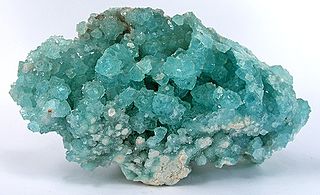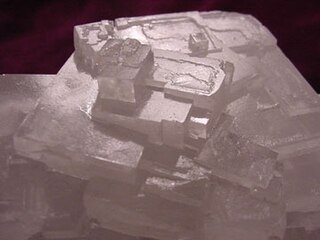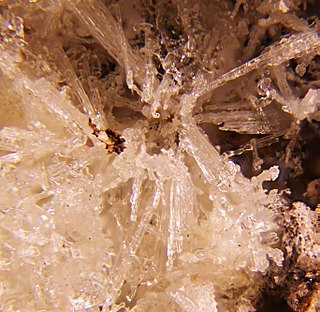Related Research Articles

Mineralogy is a subject of geology specializing in the scientific study of the chemistry, crystal structure, and physical properties of minerals and mineralized artifacts. Specific studies within mineralogy include the processes of mineral origin and formation, classification of minerals, their geographical distribution, as well as their utilization.

Calcite is a carbonate mineral and the most stable polymorph of calcium carbonate (CaCO3). The Mohs scale of mineral hardness, based on scratch hardness comparison, defines value 3 as "calcite".

The mineral olivine is a magnesium iron silicate with the formula (Mg2+, Fe2+)2SiO
4. Thus, it is a type of nesosilicate or orthosilicate. The primary component of the Earth's upper mantle, it is a common mineral in Earth's subsurface, but weathers quickly on the surface.
Borates are the name for a large number of boron-oxygen compounds usually containing oxyanions. The term "borates" may also refer to tetrahedral boron anions, or more loosely to chemical compounds which contain borate anions of either description. Larger borates are composed of trigonal planar BO3 or tetrahedral BO4 structural units, joined together via shared oxygen atoms and may be cyclic or linear in structure. Boron most often occurs in nature as borates, such as borate minerals and borosilicates.

Boracite is a magnesium borate mineral with formula: Mg3B7O13Cl. It occurs as blue green, colorless, gray, yellow to white crystals in the orthorhombic - pyramidal crystal system. Boracite also shows pseudo-isometric cubical and octahedral forms. These are thought to be the result of transition from an unstable high temperature isometric form on cooling. Penetration twins are not unusual. It occurs as well formed crystals and dispersed grains often embedded within gypsum and anhydrite crystals. It has a Mohs hardness of 7 to 7.5 and a specific gravity of 2.9. Refractive index values are nα = 1.658 - 1.662, nβ = 1.662 - 1.667 and nγ = 1.668 - 1.673. It has a conchoidal fracture and does not show cleavage. It is insoluble in water (not to be confused with borax, which is soluble in water).

In chemistry, a mesylate is any salt or ester of methanesulfonic acid (CH3SO3H). In salts, the mesylate is present as the CH3SO3− anion. When modifying the International Nonproprietary Name of a pharmaceutical substance containing the group or anion, the correct spelling is mesilate (as in imatinib mesilate, the mesylate salt of imatinib).

Ludwigite is a magnesium-iron borate mineral: Mg2FeBO5.
The rare mineral adelite, is a calcium, magnesium, arsenate with chemical formula CaMgAsO4OH. It forms a solid solution series with the vanadium-bearing mineral gottlobite. Various transition metals substitute for magnesium and lead replaces calcium leading to a variety of similar minerals in the adelite - duftite group.

Warwickite is an iron magnesium titanium borate mineral with formula: (MgFe)3Ti(O, BO3)2or Mg(Ti,Fe3+, Al)(BO3)O. It occurs as brown to black prismatic orthorhombic crystals which are vitreous and transparent. It has a Mohs hardness of 3 to 4 and a specific gravity of 3.36.

Carnallite (also carnalite) is an evaporite mineral, a hydrated potassium magnesium chloride with formula KMgCl3·6(H2O). It is variably colored yellow to white, reddish, and sometimes colorless or blue. It is usually massive to fibrous with rare pseudohexagonal orthorhombic crystals. The mineral is deliquescent (absorbs moisture from the surrounding air) and specimens must be stored in an airtight container.

Seamanite, named for discoverer Arthur E. Seaman, is a rare manganese boron phosphate mineral with formula Mn3[B(OH)4](PO4)(OH)2. The yellow to pink mineral occurs as small, needle-shaped crystals. It was first discovered in 1917 from a mine in Iron County, Michigan, United States and identified in 1930. As of 2012, seamanite is known from four sites in Michigan and South Australia.
Szomolnokite (Fe2+SO4 · H2O) is a monoclinic iron sulfate mineral forming a complete solid solution with magnesium end-member kieserite (MgSO4 · H2O). In 1877 szomolnokite’s name was derived by Joseph Krenner from its type locality of oxidized sulfide ore containing iron in Szomolnok, Slovakia (what used to be Hungary).

Howlite, a calcium borosilicate hydroxide (Ca2B5SiO9(OH)5), is a borate mineral found in evaporite deposits.

Halide minerals are those minerals with a dominant halide anion. Complex halide minerals may also have polyatomic anions.

Fluoborite has a chemical formula of Mg3(BO3)(F,OH)3. Its name comes from its main chemical components, FLUOrine and BORon. It was first described in 1926.

Huntite is a carbonate mineral with the chemical formula Mg3Ca(CO3)4. Huntite crystallizes in the trigonal system and typically occurs as platy crystals and powdery masses. The most common industrial use of huntite is as a natural mixture with hydromagnesite as a flame retardant or fire retardant additive for polymers.

Taaffeite (; BeMgAl4O8) is a mineral, named after its discoverer Richard Taaffe (1898–1967) who found the first sample, a cut and polished gem, in October 1945 in a jeweler's shop in Dublin, Ireland. As such, it is the only gemstone to have been initially identified from a faceted stone. Most pieces of the gem, prior to Taaffe, had been misidentified as spinel. For many years afterwards, it was known only in a few samples, and it is still one of the rarest gemstone minerals in the world.
Henry How was a British-Canadian chemist, geologist and mineralogist.
Bieberite (CoSO4 · 7H2O) is a pinkish red colored sulfate mineral high in cobalt content. The name is derived from the type locality at the copper deposit in Bieber, Hesse, Germany. It has been described and reported as far back as the 1700s. Bieberite primarily occurs as a secondary mineral, forming in cobalt-bearing arsenide and sulfide deposits through oxidation.
Euchlorine (KNaCu3(SO4)3O) is a rare emerald-green colored sulfate mineral found naturally occurring as a sublimate in fumaroles around volcanic eruptions. It was first discovered in fumaroles of the 1868 eruption at Mount Vesuvius in Campania, Italy by Arcangelo Scacchi. The name ‘euchlorine’ comes from the greek word εΰχλωρος meaning “pale green” in reference to the mineral’s color, other reported spellings include euclorina, euchlorin, and euchlorite.
References
- ↑ Suanite on Mindat.org
- ↑ Suanite data on Webmineral
- ↑ Suanite in the Handbook of Mineralogy
- 1 2 Watanabe, Takeo (September 1953). "Suanite, a New Magnesium Borate Mineral from Hol Kol, Suan, North Korea". Mineralogical Journal. 1 (1): 54–62. Bibcode:1953MinJ....1...54W. doi: 10.2465/minerj1953.1.54 .
| Wikimedia Commons has media related to Borates . |
| This article about a specific mineral or mineraloid is a stub. You can help Wikipedia by expanding it. |